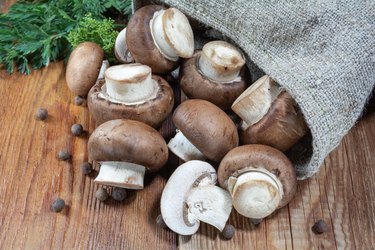
Mushrooms might look strange, but they are an integral part of Earth's ecosystem. There are more than a million identified species of them on our planet, but they share many characteristics. The world would be a very different place without mushrooms (also called toadstools) for many reasons. They are eaten as food and used in medicines. They also recycle dead organic matter, like animals and leaves, and return the material back to the soil.
General Characteristics of Mushrooms
Video of the Day
Mushrooms are produced by fungi, which are spore-producing organisms that consume organic matter. In general, mushrooms can be compared to the fruits of plants, as they are reproductive structures that some fungi generate. Mushrooms belong in a kingdom of their own and obtain nutrients by growing onto food sources, secreting enzymes to digest the food externally and absorb nutrients.
Video of the Day
Mushrooms like cool, humid and dark environments, like forest floors and basements. Unlike plants, they do not contain cellulose; instead, they are made up of chitin. This structural material forms exoskeletons for crustaceans and insects as well as clam shells and fungi walls. Chitin is a polysaccharide composed of modified glucose chains.
Mushrooms do have one thing in common with plants like ferns: Both reproduce through spores instead of seeds. The spores are spread by animal feeding, through the wind and in other ways. Once they land on an amenable surface, they germinate and grow mycelium, or microscopic rooting threads. These go into the food source and can live long after the mushroom withers away.
Famous Fungi: Mushroom Species
Mushrooms can grow into some strange-looking and fascinating formations, and fungi fans enjoy sharing toadstool pictures and descriptions. One of the scariest mushrooms is the bleeding tooth (Hydnellum peckii), found in North America, Iran, Korea and Europe. It has white caps and oozing red droplets that look like blood.
Another strange mushroom is the lion's mane mushroom (Hericium erinaceus), which has cascading white "strings" that make it look like a mop head. The amethyst deceiver (Laccaria amethystina) is much more colorful. It is a vibrant purple and has long slim stalks and button-shaped tops. The dog stinkhorn begins life in an egglike shape, later turning into a yellowish-pink rod with a brown tip. The best part is that it stretches out to its full growth within a couple of hours.
While all of those look incredible, you would not want to eat them. In fact, you should never eat a mushroom unless it has been vetted by someone experienced and/or trained in their identification. More familiar kinds of edible, commercially available mushrooms include these famous fungi: the edible white button, oyster, shiitake and Portobello. The characteristics of edible mushrooms include stalks, stems and caps, but they should also have dark slits (gills) underneath those caps.
Characteristics of Poisonous Mushrooms
While foraging for mushrooms can be an enlightening activity, it can be dangerous if the forager does not know how to identify poisonous varieties. Toxic species often have white gills or rings around their stems. Make sure to also avoid mushrooms with red stems or caps and those that have unpleasant smells.
There are other warning signs for which to look as well. Some poisonous mushrooms have bulbous cups close to their bases, which are called "volva." These can be above ground or underground and are only visible when pulled up. Scales or warts on the mushroom's cap are other characteristics for which to watch out as well as caps that resemble an upside-down letter U.
There are online mushroom guides with plenty of pictures and details to which foragers can refer. The safest course of action is to wear gloves, gather the mushrooms in a bag or container and take them home. It is never smart to pick and eat before checking. Some mushrooms may appear completely safe but are actually quite toxic.